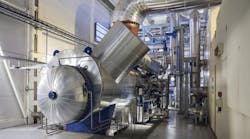Principle of Operation: Vortex flowmeters make use of a principle called the von Kármán effect. According to this principle, flow will alternately generate vortices when passing by a bluff body. A bluff body has a broad, flat front. In a vortex meter, the bluff body is a piece of material with a broad, flat front that extends vertically into the flowstream. Flow velocity is proportional to the frequency of the vortices. Flowrate is calculated by multiplying the area of the pipe times the velocity of the flow.
In some cases, vortex meters require the use of straightening vanes or straight upstream piping to eliminate distorted flow patterns and swirl. Low flowrates present a problem for vortex meters, because they generate vortices irregularly under low flow conditions. The accuracy of vortex meters is from medium to high, depending on model and manufacturer. In addition to liquid and gas flow measurement, vortex flowmeters are widely used to measure steam flow.
Technology & Market Trends: Vortex flowmeters are well suited for measuring steam flow, and they are widely used for this purpose. Steam is, arguably, the most difficult fluid to measure. This is due to the high pressure and high temperature of steam, and because the measurement parameters vary with the type of steam. Main types of steam include wet steam, saturated steam, and superheated steam.
Multivariable & dual-sensor technologies offered in vortex flow meters
Steam is often measured in process plants, and for power generation. Vortex and DP flowmeters are the primary meters used to measure steam. Magnetic flowmeters cannot measure steam flow, and Coriolis and ultrasonic flowmeters are just beginning to be used for this purpose. In addition to their ability to tolerate high process temperatures and pressures, vortex meters have wide rangeability. This allows them to measure steam flow at varying velocities. In process and power plants, steam is often measured coming from a boiler.
Sierra Instruments (www.sierrainstruments.com) introduced the first multivariable vortex flowmeter in 1997. This meter included an RTD temperature sensor and a pressure transducer with a vortex-shedding flowmeter. By using the information from these sensors, the flowmeter can determine volumetric flow, temperature, pressure, fluid density, and mass flow. This multivariable flowmeter is one of a growing number of multivariable new technology flowmeters, including multivariable magnetic flowmeters and multivariable DP flowmeters. Multivariable ultrasonic flowmeters are popular in district heating applications.
In the past several years, a number of new suppliers have introduced multivariable vortex flowmeters. These include ABB, Yokogawa, KROHNE, EMCO, and Endress+Hauser. While multivariable flowmeters are somewhat more expensive than their single-variable counterparts, they enable end-users to obtain significantly more information about the process than a single-variable volumetric meter. This additional information can result in increased efficiencies that more than make up for the additional cost of the multivariable flowmeter. Multivariable vortex flowmeters also have the capability of measuring mass flow, and this makes them attractive, especially for steam and gas flow measurement.
Considering the application versatility of vortex flow meters
News & Notes: In the past five years, a number of companies that previously had only single-variable vortex flowmeters have entered the multivariable vortex flowmeter market. In addition to this, some new companies have entered the vortex flowmeter market that did not previously offer vortex flowmeters. These companies include Aalborg (www.aalborg.com), Yamatake (www.yamatakeamerica.com), and Nice Instrumentation (www.niceinstrumentation.com). Racine Federated (www.racinefed.com) purchased the industrial vortex flowmeter product line from J-TEC Associates (www.j-tecassociates.com) and also acquired Asahi America’s (www.asahi-america.com) vortex flowmeter product line. Spirax Sarco (www.spiraxsarco.com) purchased the vortex flowmeter line from EMCO Flow Systems (www.emcoflow.com). Universal Flow Monitors (www.flowmeters.com) brought out a new line of plastic vortex flowmeters called Cool Point. The presence of these new suppliers and product lines is injecting new life into the vortex flowmeter market and helping to spread this technology to still more end-users.
Jesse Yoder, Ph.D., is president of Flow Research, Inc. in Wakefield, Mass., a company he founded in 1998. He has 22 years of experience as an analyst and writer in process control. For more on Flow Research’s coverage of vortex flowmeters, visit www.flowvortex.com.


